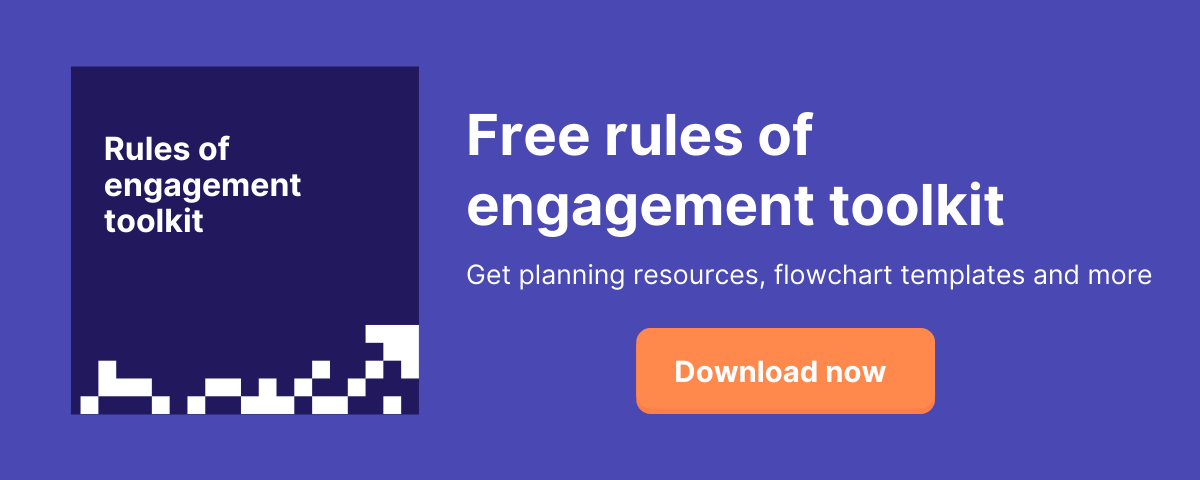We spend a lot of time talking to revenue and sales leaders. And one of the things that frequently comes up in those conversations are sales rules of engagement.
What are rules of engagement?
Generally, sales rules of engagement (aka RoE) are an attempt to codify everything your company needs to know about which sales reps work which accounts - and when - throughout your customer lifecycle. They dictate who has ownership over accounts, who gets credit for deals, and how sales teams work together. Defining sales engagement with effective RoE leads to more productive, happier teams, smoother customer interactions, and higher and faster close rates.
We all know the importance of clear, consistent, and comprehensive rules of engagement. But of course, it’s actually incredibly difficult to do that in reality. Sales teams are complex and the B2B buying process is always changing. And while most sales reps are honest people just trying to do the right thing, RoE directly impacts rep compensation, and that can make some reps take shortcuts.
It’s almost impossible to create a set of rules of engagement that cover every possible edge case AND account for all the ways things can go sideways. So conflicts are bound to come up. Those conflicts can be time-consuming and stressful to resolve.
So let’s talk about some of the challenges that come with rules of engagement in business. What sorts of things are revenue leaders dealing with around RoE? Why is this so complicated?
Sales rules of engagement can be challenging in many ways
Deal complexity. If your company has complex deal parameters, like channel partners, accounts with parents and/or subsidiaries, or multiple product lines, it inevitably leads to more RoE conflict. Who takes ownership of a parent company if one of its subsidiaries is already a customer? What happens when a rep who is tasked with selling Product A learns a prospect is talking to another rep about Product B? How do you handle inbound prospects from partners? The more complex your deal profile is, the more likely you are to run into RoE issues.
Data, or lack thereof. Effective RoE relies on clean data and a tidy CRM. It means you need enough information about a prospect to know how to assign it - things like company industry, revenue, employee count, location, and more. It also means your CRM really has to be the single source of truth in your organization, and that everyone keeps opportunity data up-to-date. A lot of RoE challenges begin as data quality issues before turning into a full-blown conflict.
Market segments. How well-defined are your territories or market segments? It can be hard to account for every possible market segment. Even if you’re dealing with geographic territories, how do you distribute those territories evenly among reps? Finding the right market segmentation - one that both is and feels fair - is hard. Further, you likely have to tweak this regularly, causing confusion about who’s supposed to work which segment.
Attribution, especially as it relates to marketing. Attribution requires accurate lead-to-account matching to be sure inbound leads are always matched to existing accounts when appropriate. It also means you need clear rules about who gets credit when an outbound rep is working a deal that also inbounds around the same time. How do you keep your inbound and outbound efforts in sync?
Dishonest rep behavior. It’s not common, but it happens, especially in larger organizations; sometimes reps will deliberately break the rules to get to the better deals. That includes things like:
- Reps hoarding lost or quiet opportunities or changing opp dates to hold onto them longer than the normal ownership time. These are the Rick Astleys of your sales team (because they’re never gonna give a deal up).
- “Salesforce surfers,” which is what one revenue leader calls reps who try to attach themselves to a deal in progress for partial credit. You may also recognize these reps as fairweather fans, low-hanging fruit pickers, and the like.
- Reps changing account names or other data to hide an account or make it look like an account should be in their territory even when it’s not.
- Reps who work a deal through to close, and then discover a “mistake” in the data that meant that deal never should have been theirs. They should get credit since they worked it though, right? Right?!
These challenges are compounded if reps perceive scarcity in deal flow, if there are issues of trust in your sales team, if your company is growing quickly, if you have a highly competitive environment, if there’s rep turnover. So many factors can contribute to RoE conflict that it’s no wonder it’s so complicated.
So, how do you solve this? So glad you asked! We've developed a free RoE toolkit that includes a template for effective RoE, as well as tips for reducing conflict.
What challenges did we miss? What else causes rules of engagement conflict? We’d love to hear from you - leave us a comment on LinkedIn.
And of course, if you're dealing with RoE challenges, maybe we can help.





